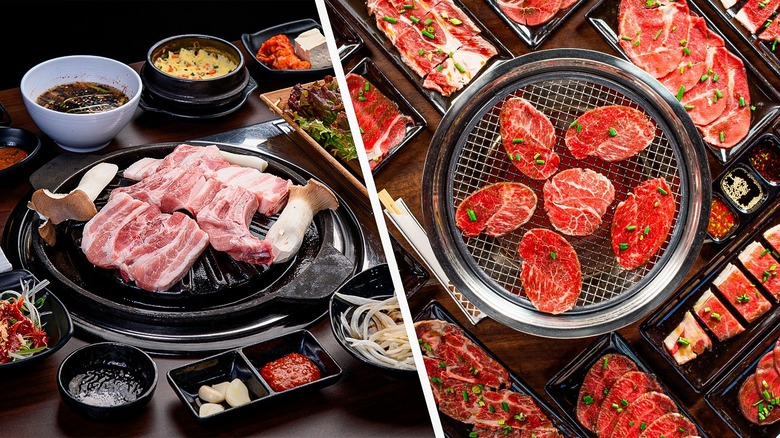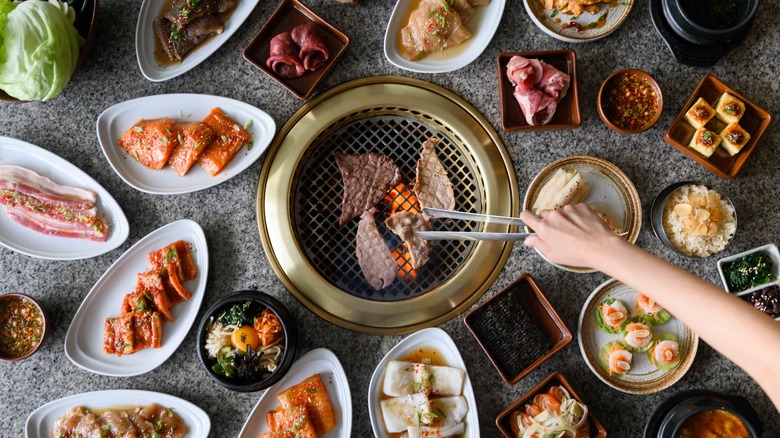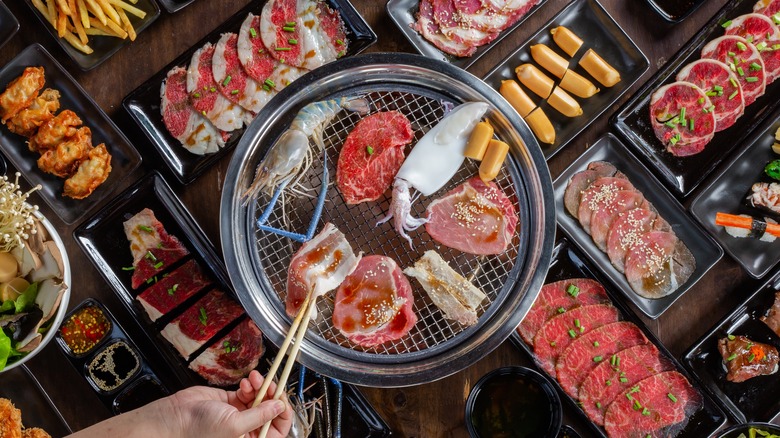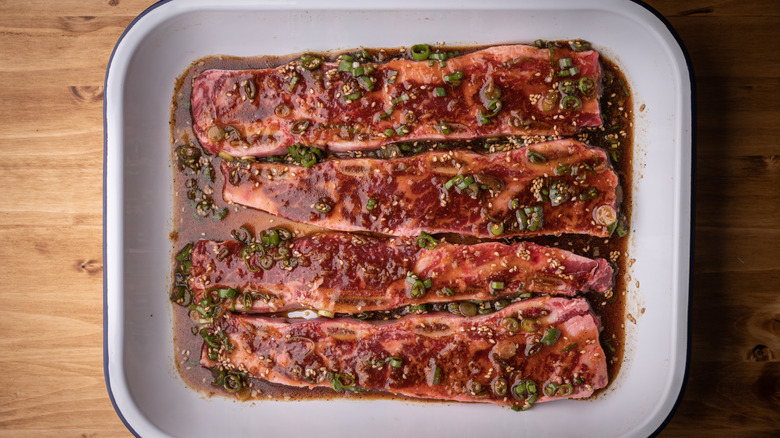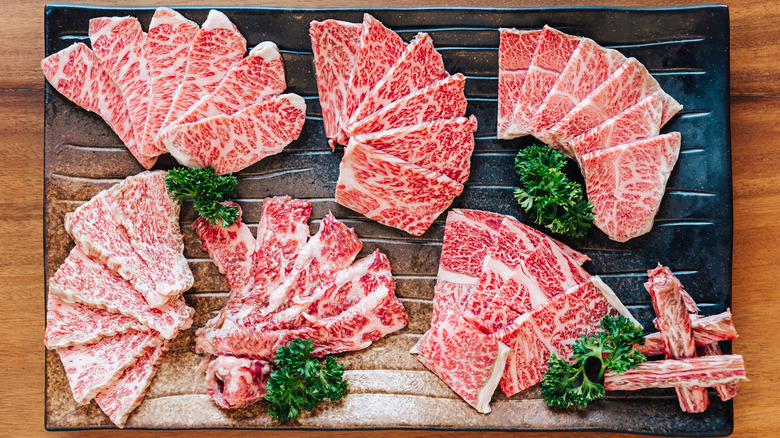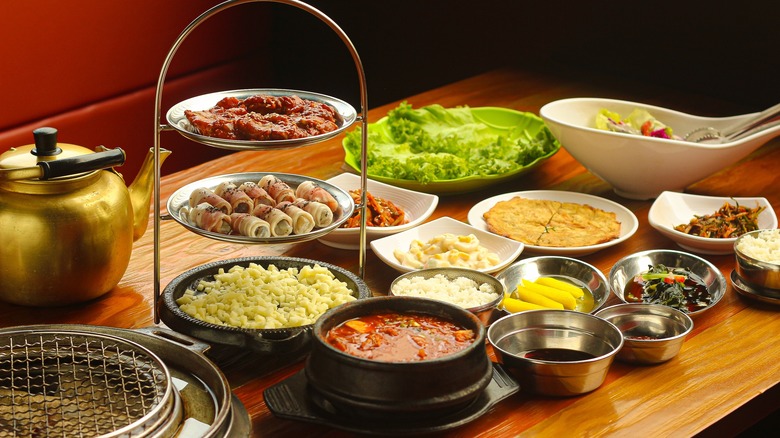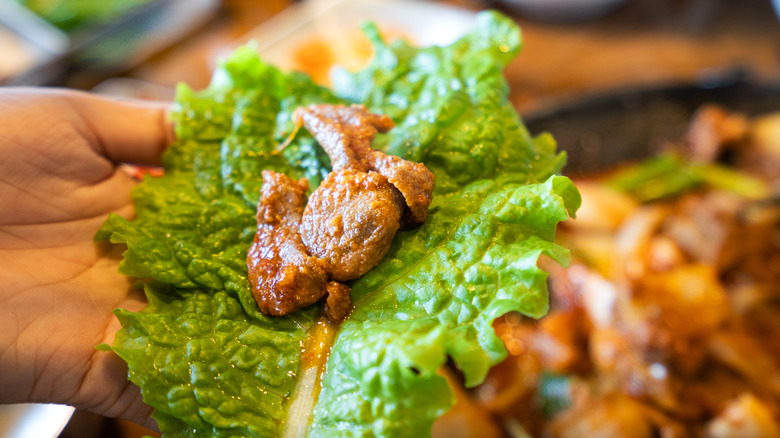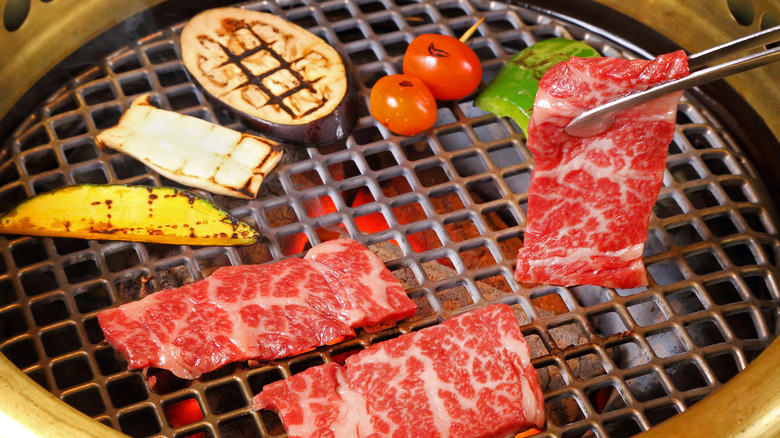Korean Vs Japanese BBQ: What's The Difference?
The mention of barbecue can immediately conjure images of outdoor cooking and the scents of a smoky grill browning chunks of meat and deliciously charred vegetables. In Asia, however, two culinary cultures have perfected the art of grilling meat indoors.
Korean and Japanese cuisines have their respective styles of cooking barbecue. Just like in American culture, barbecues are social events in both countries. But what makes these Asian versions conducive to indoor cooking is their use of tables that have built-in grills at the center, powered with either gas, charcoal, or electricity. Diners or guests are also free to cook their own choice of meat cuts, which is why you'll find the meat served in both Korean and Japanese BBQ joints already sliced into thin portions. People can then cut these into smaller, bite-sized pieces with provided kitchen shears and place them on the grill, flipping them with tongs or chopsticks until cooked. It's not just the communal eating but also the communal cooking that makes these dining styles enjoyable. Plus, both are usually enjoyed with alcohol to enhance the sense of conviviality around the table.
Beyond these similarities, however, Korean and Japanese BBQ have distinctive characteristics that make each one special. Get to know their differences so that when you find yourself craving grilled meat, it's easier to choose between the two, depending on what you're hungry for.
What is the history of Korean BBQ?
An increasingly trendy way of dining in the U.S., Korean BBQ, aka KBBQ or gogigui was shaped by significant events and cultural developments in Korean history. Its earliest version can be traced to the wandering Yemaek tribe's practice of storing meat in a marinade as they traveled across Korea, reaching as far as Manchuria, during the Koguryŏ era (3rd century B.C. to 1st century A.D.). This culinary method became known as maekjeok, a combination of the tribe's name (maek) and the Korean word for skewers (jeok), which were used to cook meat on an open fire. Maekjoek later on evolved into the brothy seoryamyeok, which had marinated beef or bulgogi soaking in cold water. By the early 20th century, it had further developed into neobiani, which had bulgogi thinly sliced then charbroiled for the enjoyment of royalty.
During the Japanese occupation from 1910 to 1945, Koreans had very little access to meat due to its scarcity and the resulting exorbitant prices. Upon the country's liberation at the end of World War II, they rediscovered their love for it. Bulgogi, especially, became widely loved, and ribeye became bulgogi's go-to cut. The traditional way of marinating beef then thinly slicing it to prepare it for grilling became the standard preparation for all kinds of meat when making Korean BBQ.
What is the history of Japanese BBQ?
Japanese BBQ has a much shorter history than the Korean equivalent. Due to Japan's background as a traditionally Buddhist country, eating meat was considered taboo, even illegal for centuries. It was only during the Meiji period, which started in 1868, that the strict dietary restriction was lifted, along with Japan's self-imposed isolation. As skewered and grilled chicken or yakitori started to become a popular kind of street food, eating beef and pork also became more accepted, thanks to the influx of Korean and Chinese influences in the country. The wave of Korean immigrants during the 1920s specifically introduced the tradition of grilling bulgogi. The Japanese adaptation of the dish became known as yakiniku, from the Japanese words for grilled (yaki) and meat (niku).
The influx of meat imports from the U.S. after World War II, which skyrocketed from the 1970s onwards, further heightened yakiniku consumption in Japan following the lean years during the war. Whereas only the rich could afford it before, the less prohibitive price of available meat meant that more of the public could finally have access to yakiniku.
Today, the city of Kitami on Hokkaido Island is known as the Town of the Yakiniku, with around 60 yakiniku restaurants in the area. The presence of a meat-processing plant and animal farms in nearby municipalities contributed to the development of its meat-eating culture. It's a great place to visit to enjoy a variety of grilled meat, from wagyu beef to horumon or offal.
Marinade is a crucial aspect in Korean BBQ
A key difference between Korean and Japanese BBQ is the former's use of marinade. The classic Korean marinade combines sweetness with tanginess, saltiness, and umami for a balanced medley of flavors to better highlight the meat. It usually features soy sauce mixed with sesame oil, sesame seeds, garlic, ginger, black pepper, sugar, and scallions. The juice of Asian pears (which are different from the US-grown Bartlett pears) is also used to sweeten and tenderize the meat. Red chili pepper paste or gochujang can be added as well, and is often paired with pork, which is considered to have a more intense flavor than beef.
Most Korean BBQ restaurants put the spotlight on only a single type of meat, whether it's bulgogi beef, galbi (short ribs), pork belly (samgyeopsal), or chicken (buldak). For those who prefer to grill at home, selecting the best cuts of meat for Korean BBQ means looking for succulent and fatty pieces so you get the taste and sizzle you're looking for in a good grill.
Japanese BBQ lets the meat flavor come through
Flavor is also prized in yakiniku, but rather than boosting it with a rich marinade, the Japanese prefer to let the natural taste of the meat come through, aided with just salt, pepper, and few other spices. This makes the quality of the meat an essential consideration, since there's hardly anything to disguise it.
Yakiniku does have its signature sauce. Both savory and sweet, yakiniku no tare is usually soy sauce-based, though you can also find miso- and salt-based products, too. In addition to soy sauce, it has mirin, sugar, sesame seeds, sesame oil, and grated ginger and garlic, with chili peppers added in for those who like some heat. It can be used as seasoning and a dipping sauce, as well as a light marinade. Yakiniku restaurants also serve teriyaki or ponzu sauce, but only for dipping.
While Japanese BBQ also features pork, chicken, fish, and other types of seafood, its main focus is beef. The most popular cuts used in yakiniku are short ribs (karubi), roast and rib roast, and sirloin because of their marbling. The leaner skirt steak (harami), found between the cow or the pig's rib cage and abdomen, is also used because of its intense flavor. Another popular choice is beef tongue (gyūtan) due to its soft and delicate flavor; it's advised to grill this first before the other cuts so you can savor its unique taste.
Multiple side dishes are a must in Korean BBQ
Just as Koreans prefer a balance of flavors in their marinade, their side dishes for BBQ also provide a delicious contrast to the meat. Collectively called banchan, these accompaniments are served in small plates early on in any Korean meal.
There are thousands (if not millions) of kinds of banchan available. Most are made with vegetables presented either fresh, like blanched spinach (sigeumchi namul); braised in soy sauce, like soy-glazed potatoes (gamja bokkeum); or fermented, like kimchi. Fried fish cakes, eggs (either simmered in soy sauce or cooked as rolled omelets or gyeran-mari), and fried dried shrimp or anchovies are also common choices. In a Korean BBQ, banchan serve as palate refreshers from all that rich, fatty meat.
According to food blogger Kim Chan-Sook (via Afar Magazine), in accordance with Eastern philosophy, the number of side dishes served in each meal must be an odd number to bring good luck. They should also collectively present five colors — green or blue, red, yellow, white, and black — to symbolize the five directions, including the center or the originating point. That's why you shouldn't be surprised by the sheer variety of banchan served with your KBBQ. Best of all, asking for a refill is perfectly normal since both Korean dining establishments and Korean households prepare them in bulk.
Korean BBQ cuts are often eaten wrapped in leaves
Among the numerous banchan served with Korean BBQ, you'll also find a plate of fresh lettuce or perilla leaves. These are used for ssam, which is wrapping grilled meat into an edible green parcel, complete with dollops of a thick, sweet, and savory sauce called ssamjang. Aside from packaging the meat into a bite-sized bundle, ssam also lets you pack each bite with garnish, such as sliced garlic cloves and slivers of green Korean chilies, to create a harmony of flavors and textures. For a truly flavorful addition, you can put the garlic on the grill to roast it a bit. Or, even better, ask your server for a small metal bowl with sesame oil in it, place it on a corner of the grill, and drop in garlic cloves to fry.
Even the choice of using lettuce and perilla leaves is about balancing flavor since they impart an herby freshness to each bite. Perilla, in particular, has a more distinct slightly bitter and anise-like taste and aroma that contrasts well against the meat.
Vegetables are grilled with the meat in Japanese BBQ
Yakiniku is often served with platters of fresh seasonal vegetables that can be grilled alongside the meat. They range from starchy produce like kabocha squash and Japanese sweet potatoes to smaller, quicker-cooking ones like sweet onions, eggplants, and shishito peppers. Shiitake and king oyster mushrooms are also common sides, as are sweet corn and green cabbage.
A little prep is needed to make the veggies ready for grilling. This usually involves slicing them into smaller portions, although certain produce requires extra steps. Corn, for example, is wrapped in a moistened paper towel and then popped into the microwave for two minutes. Afterward, once the paper towel and silk-like threads have been removed, the corn is sliced into one-inch cross-sections before hitting the grill. With cabbage, the core and tough ribs are cut off before chopping the leaves into 1-inch squares. As for Japanese sweet potatoes, they are usually soaked in water for 10 minutes to remove some of the starch, before being patted dry then grilled.
In terms of side dishes, some of the most popular are steamed rice, edamame, miso soup, and Japanese-style potato salad. Since Japanese BBQ originated from Korean BBQ, it's not strange to find Japanese establishments that serve banchan, too, like kimchi, seasoned spinach, and bean sprout salad. The Korean style of wrapping grilled meat in lettuce leaves has also been adapted by the Japanese.
